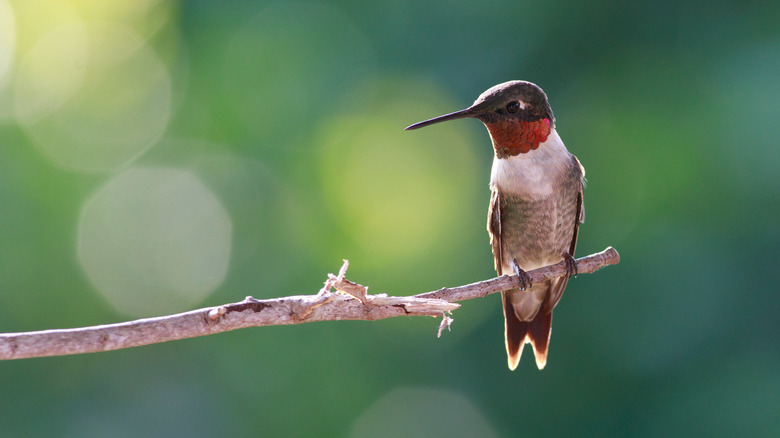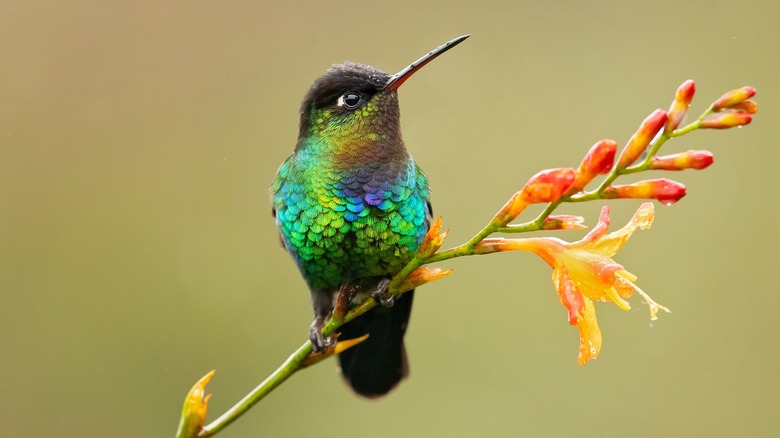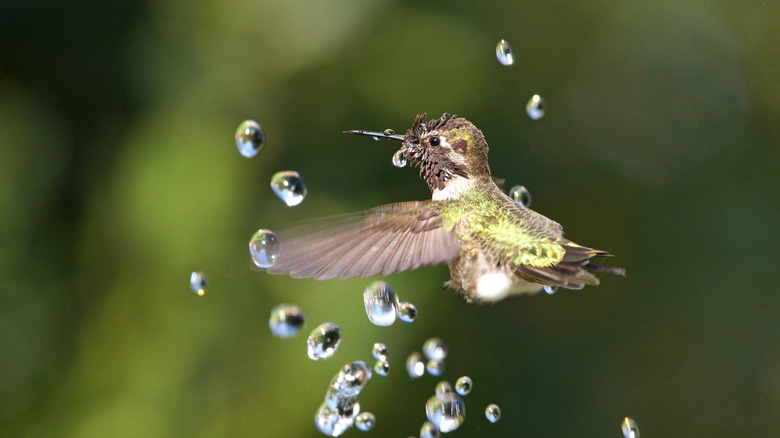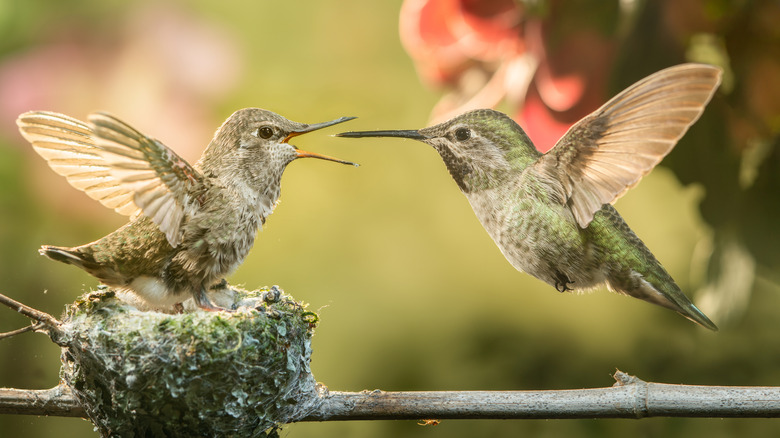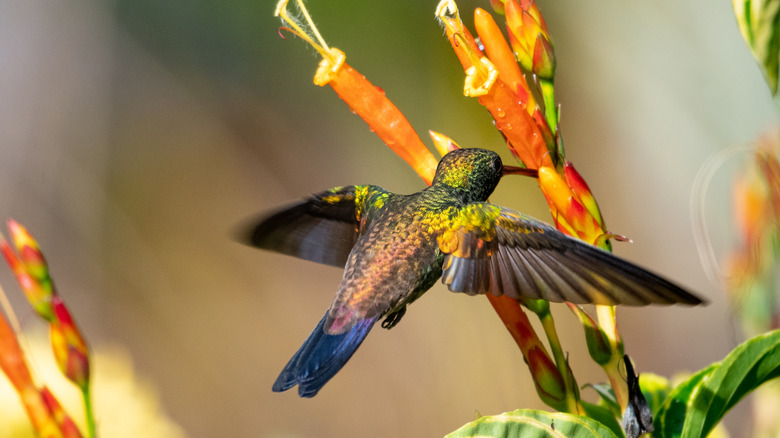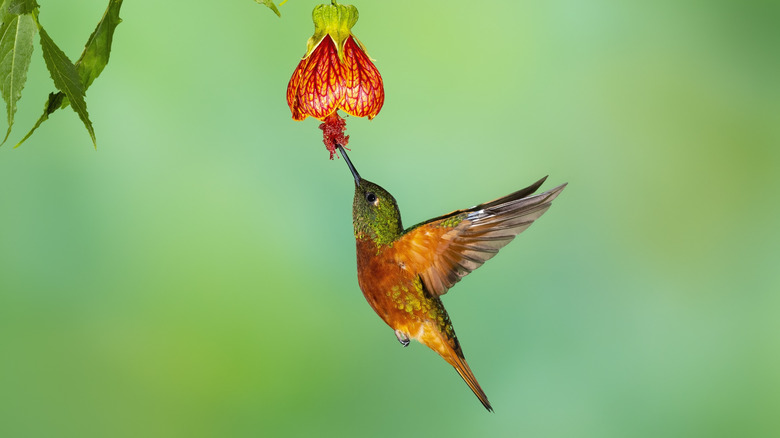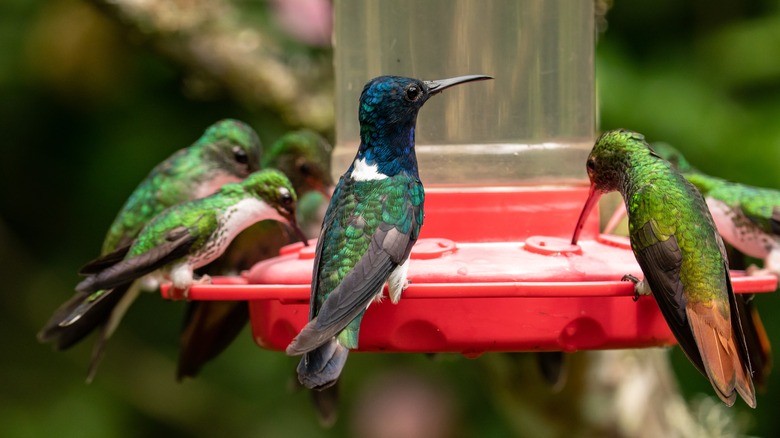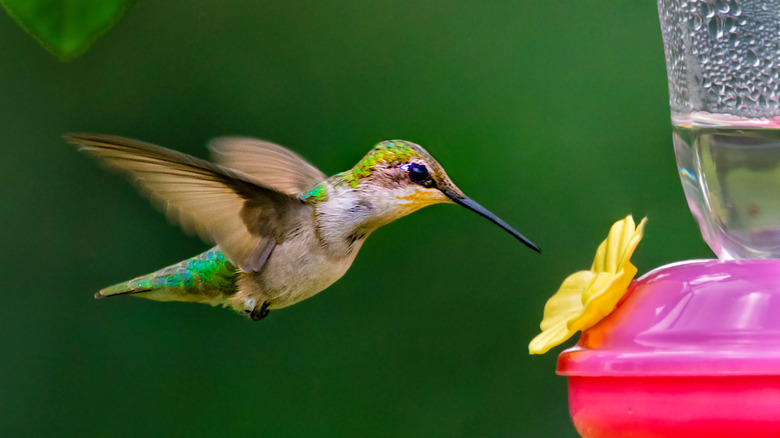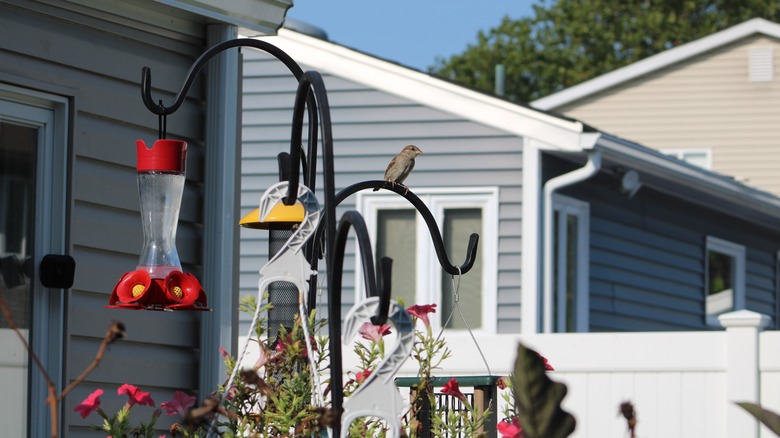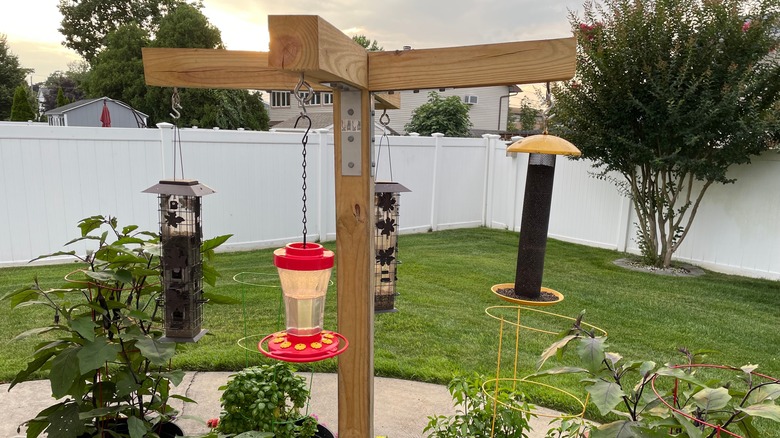9 Reasons Hummingbirds Are Steering Clear Of Your Yard
There's nothing like the breathtaking and iridescent blues, purples, and greens of a hummingbird to bring a bit of joy and color to your yard. However, these winged wonders are extremely picky about what environments they choose to grace with their presence. There's a whole host of reasons why your yard is not benefitting from their soothing hum, their sublime hovering, and their chirpy nature. However, the good news is that if your home is situated in a geographical hummingbird hotspot, then there's no reason you cannot make it hummingbird friendly.
There are over 350 species of hummingbirds, but the ones most commonly found feeding in America's backyards include the ruby-throated hummingbird, black-chinned hummingbird, Rufous hummingbird, and Anna's hummingbird. And depending on where you live, you could encounter even more variety. However, you may find that you aren't seeing even the most common native species stop by your home. Here are the reasons why they're probably steering clear of your yard, as well as the steps you can take to make your yard more hospitable.
Your yard is too noisy and hectic
If you've ever walked through a forest at midnight or strolled across a beach at dawn, you'll appreciate the solitude and silence that best defines nature. The great outdoors may be teeming with life, but that life keeps itself on the down-low and cannot abide noise. Hummingbirds are no different! Although your yard may not sound noisy to you, to a cautious and timid hummingbird, it can sound like a juke joint at full steam on Saturday night. Raised voices, barking dogs, loud stereos, and particularly wind chimes will ensure hummingbirds avoid your yard like a plague.
The eerie melody of the wind chimes is unsettling to the skittish hummingbird and they don't tend to hang around once the unmistakable chimes have made their presence known. Although, if your yard contains enough nesting and feeding sites, hummingbirds will eventually adapt to the noise made by the wind chimes — but why take the risk? Bear in mind that as well as loud noises, hummingbirds are scared away by other stimuli, such as flashing lights and, of course, natural predators like hawks and cats. To create a safe and secure environment for hummers in your yard, deter cats and other predators as much as possible. Keep your hummingbird feeders away from sources of noise and light. And when you're in the yard, talk softly and avoid jerky movements.
You don't have enough water features
Water features are attractive to hummingbirds, but not for drinking purposes. A hummingbird drinks nectar to keep hydrated, and the reason hummingbirds are so fond of water is all that nectar can leave them feeling sticky and a bath or makeshift shower keeps their feathers clean and flight ready. A quick dip also helps them unwind when the temperatures soar.
Standard bird baths are not shallow enough for a dainty little hummingbird. Unique water features are more their cup of tea. A gentle trickle of water that provides hummingbirds with a wet area is their idea of bliss. Fountains that cascade over the edge of shallow basins are also perfect for weary hummers to scrub away the trials and tribulations of the day. A lawn sprinkler set to a spray or mist mode can also provide a great flying bath for the daredevil hummingbird. Keep all water features clean and sterilized on a weekly basis during the summer months.
There's nowhere for them to set up home
All of god's creatures need a roof over their heads, a place to call their own and a place to retreat and lock the doors against the big, bad world. Hummingbirds are no different! Hummers are always most likely to nest in a place where there's a large selection of flowers that provide them with the nectar they crave. Or at least enough feeders to cater to their dietary requirements. Hummingbirds don't like board boxes or tree cavities. They nest on tree limbs and other surfaces that are horizontal and small. Lichens, twigs, leaves, plant fibers, and spider webs are their preferred materials for construction.
Hummingbird nests are rarely seen because they are so small and look like a bump on a branch from below and a scattering of leaves from above. Out of sight and out of mind is a hummer's philosophy when nesting, and they build their homes 10 to 90 feet high. To encourage nesting ensure you have a diverse range of shrubbery and small deciduous trees at the edges of your yard. This will provide hummingbirds with the protective cover of varying heights they need to nest in peace. Hummers love willows, American elm, birch, beech, mulberry, maple, witch hazel, alder, and cottonwood. Providing plenty of perches in your yard for hummers to chill and check their territory will also encourage them to become frequent visitors.
Your yard lacks colors
If there's one thing everyone notices about hummingbirds it's their colors. When they flap their wings and hover, they can appear as enchanting as a rainbow and as elusive as sunlight playing upon the water. Like is attracted to like, and if your yard doesn't boast an array of dazzling shades and hypnotic hues, hummers may give it a wide berth. Hummingbirds cannot smell, but have a keen eyesight and are particularly attracted to the colors red, orange, pink, and yellow. Flower blossoms that boast these shades are considered to possess more sucrose. This is a type of sugar that hummingbirds can easily digest.
To entice hummingbirds to your yard, consider planting a variety of plants in drifts of color that a wandering hummingbird will be irresistibly drawn to, with a focus on the color red. You can also lure them in by adding bright red feeders to your yard. Another trick is to tie red ribbons on the tree branches and porch railings of your home. The bold bright color will act as a sire to call them in and once they see there's an abundant and ever-ready supply of food they'll probably stick around for the duration. A word of warning though, never use any artificial colored feeding solutions. Its safety has not been proven and there is anecdotal evidence to prove that it is dangerous to hummers, particularly because the amount of dye in nectar solutions is not regulated. Having red-colored feeders and flowers is more than enough to entice a hummingbird on the wing.
Your flowers are not hitting the sweet spot
As we've already established, hummingbirds love bright colors, and filling your yard with red, orange, and pink flowers is a great start when it comes to inviting them in. As one of nature's pollinators, hummers love nectar-rich flowers, particularly those which are tubular and allow their long and narrow beaks easy access. A variety of flowers that bloom at different times provide hummingbirds with a plentiful food supply. However, it's still possible to attract them to your yard with only a few enticing blooms. Petunias or fuchsia in a hanging basket give hummers with a safe and secure place to sup their fill of nectar, but for the welfare of the birds and bees don't use insecticides or pesticides.
Red columbines provide hummers with a great deal of nutrition and they cannot resist some healthy sunflowers. The perennial shrub hummingbird fuchsia is a magnet for hummers and they all adore bee balm. Cardinal flowers, delphiniums, trumpet flowers, red hot pokers, and common yarrows are also popular choices for these nectar connoisseurs. A butterfly bush is easy to grow and some gardeners report the flowering shrub attracts more hummingbird visitors than any other. Pride of Madeira is a drought-tolerant evergreen and a popular choice for both hummingbirds and butterflies. The bright blooms of zinnias are a reliable hit as well. Bleeding hearts, foxgloves, and salvia are also rich sources of nectar. Be sure to plant your flowers out of the reach of predators as much as possible.
You're not providing them with other food sources
It's no secret that hummingbirds love nectar. It provides the frantic fliers with energy and as an added boost stops them from getting dehydrated. To get the nectar they need, hummingbirds have been known to visit anywhere between 1,000 to 2,000 flowers in a 24-hour period. Yet, don't make the mistake of thinking that's all they eat. Hummers have big appetites and an even bigger metabolism. They devour 50% of their body weight every day and need the protein, amino acids, minerals, and vitamins that other food sources provides. As well as nectar, their diet includes tree sap, pollen, small insects, fruit, and even a little grit.
To entice hummers to your feeder with a little homemade hummingbird nectar, mix 4 cups of water with 1 cup of refined white sugar. This creates a formula close to the sucrose levels flowers produce. Never use artificial sweeteners, honey, fruit juice, brown sugar, or molasses, and never add red dye to the solution. A little soft and overripe fruit, particularly if it's red, is perfect for hummingbirds to drink from. Because the fruit will also attract insects, it's a double whammy for a hungry hummer. Hummingbirds like to eat a little grit with their insects for purposes of digestion. It also acts as a source of minerals. So, place a little dish near your feeders and the hummers will love you for it.
Your yard only has one feeder
Feeders are an essential part of the strategy for enticing hummingbirds into your yard. So don't make the mistake of hanging one and thinking that will do the trick. They may come across as cute little critters who have flown straight out of a Disney movie, but don't be fooled! Hummingbirds have huge appetites and are extremely territorial. A male is capable of aggressively claiming a feeder as his private property. He'll then spend his days feasting and chasing other hummers away from the dinner table.
To make your yard attractive to more than one feisty, extremely vocal, and gluttonous hummingbird, equip it with more than one feeder. Hang your feeders at 10 feet intervals and you'll attract hummers with a wide range of personalities to your yard. Experts tend to agree that the flying saucer-shaped feeders are your best bet. They're easy to clean and refill, and the sugar water is usually safely out of the reach of bees and wasps — but still within reach of the long tongue of the hummer. However, you also can't go wrong with a classic glass bottle feeder.
Your feeders are in the wrong location
So, you've hung multiple feeders and the hummingbirds are still keeping their distance — it's probably because you've hung them in the wrong location. To ensure our little feathered friends become frequent visitors, ensure you hang the feeders as close to any flowers in your yard as possible. Also, hang them in areas that are sheltered and where the birds can feel safe. Hummers do not want to feed in a barren and open space where they can be attacked from all angles. They will also need plenty of the perching places that nearby trees and shrubs provide.
Do not place the feeders in direct sunlight because the shade will help the nectar last longer. Finally, the reason everyone wants to entice hummingbirds to their yard is because it is such a joy to watch their antics. Remember to place the feeders in a place that is visible from the comfort of your own home.
You hung the feeders during the wrong time of year
Each spring and fall the majority of hummingbirds fly thousands of miles and burn vast reserves of energy to get where they need to be. If that place turns out to be your yard, you better ensure you have plenty of feeders stocked with some freshly-made nectar ahead of their arrival. From a hummer's point of view, it's a much-appreciated welcome feast after a hard road traveled. Think of your yard as a hummingbird hotel and a full feeder as a red carpet. If your yard has no vacancies, they'll waste no time in moving on to the next one.
The same rule applies in the fall when the hummingbirds are packing up their bags and preparing for the great exodus. Don't be in a rush to take down the feeders because you have hummers who still rely on them. On a final note, always change the sugar water in your feeders before it ferments and goes bad. Rotten nectar is a natural repellant for hummers and will see them flying for the nearest exit. Cloudy nectar that has floating insects in it is a dead giveaway that it's time for change. Always thoroughly wash your feeders at the same time as you change the sugar water. Washing your feeders is important because it removes any lingering mold or impurities that could lead to a build-up of bacteria. Follow these tips and your yard will soon become a haven for hummingbirds.
